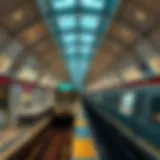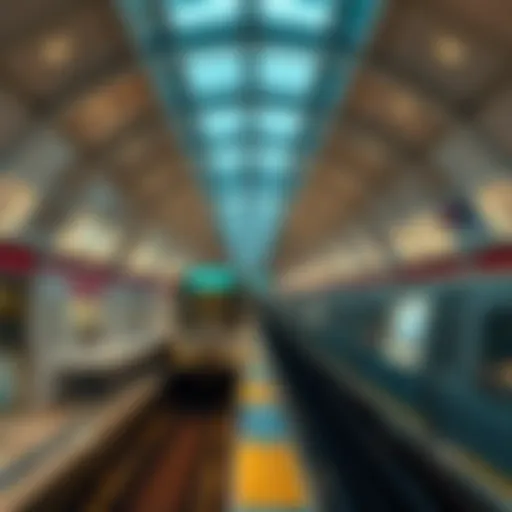Dubai Metro Operational Timings for 2022
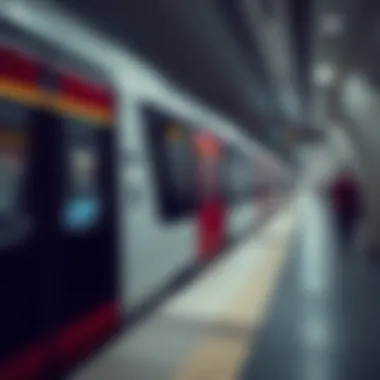
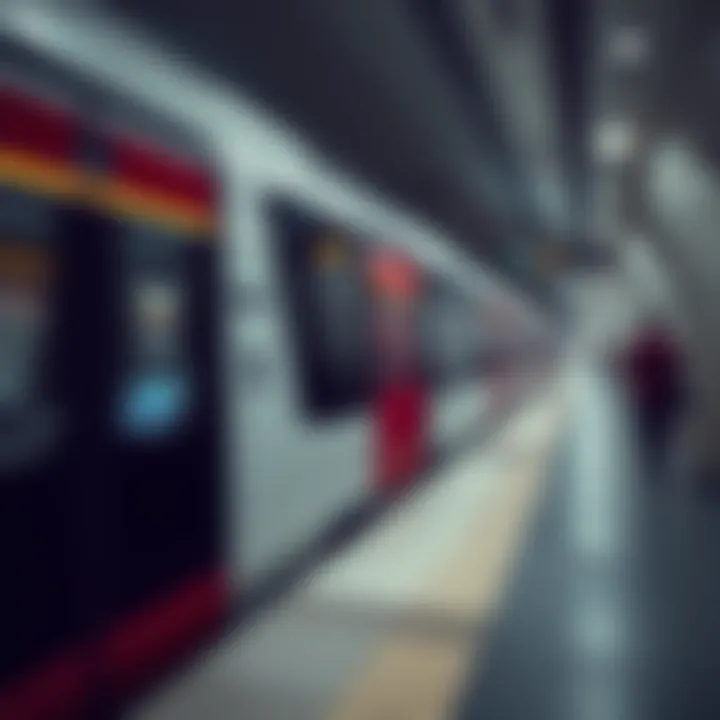
Intro
Navigating the bustling metropolis of Dubai can feel overwhelming at times, especially for those who are not familiar with its intricate transport systems. The Dubai Metro, a marvel of modern engineering, plays a pivotal role in the daily lives of both residents and visitors. Its operational hours, adjusted for varying demand throughout the week, determine how effectively one can maneuver through the city. Understanding the timings of the metro is essential; it not only facilitates seamless commuting but provides insight into the vibrant pulse of Dubai itself.
In this article, we will dissect the operational timings of the Dubai Metro in 2022—breaking down its schedules, peak hours, and adjustments made for weekends and public holidays. We will also highlight how such a comprehensive grasp of metro timings benefits individuals, whether they're daily commuters, tourists, or expatriates new to the city. Ultimately, we aim to shine a light on the crucial role the metro system plays in connecting the various facets of urban life in Dubai.
As the city continues to expand and modernize, an understanding of the metro's workings becomes ever more significant. With the right information, riders can optimize their journeys, avoid peak hours, and tap into the convenience that Dubai Metro has to offer.
Overview of the Dubai Metro
The Dubai Metro, an essential backbone of the city’s public transport, is far more than just a means of getting from point A to B. With its sleek design and state-of-the-art technology, the metro system weaves through the heart of Dubai, playing a vital role in urban mobility and transport integration. For those living, working, or visiting this vibrant city, understanding the metro's operations is not just an academic exercise; it’s a necessity.
A Brief History
When contemplating the evolution of this remarkable transit system, it’s interesting to note that the first line, the Red Line, opened in September 2009. The launch marked a significant milestone for Dubai, symbolizing its rapid advancement toward modernization and urban planning. Initially, skepticism loomed over how well the system would be utilized. Would people embrace this new mode of travel? Would it significantly alleviate the traffic chaos notorious in the city?
Fast forward to today, and the answer is a resounding yes. The metro system has expanded, bringing additional lines into operation, including the Green Line, which was inaugurated in August 2011. This growth mirrors Dubai's trajectory as an economic hub, accommodating an ever-increasing influx of residents and tourists.
Importance in Urban Transport
The relevance of the Dubai Metro cannot be overstated. It's not simply a transport system; it reduces traffic congestion, curbing pollution effectively within the densely populated areas. More so, it connects key locations, linking residential areas to shopping malls, business districts, and major tourist attractions, effectively knitting together the urban fabric of Dubai.
"The metro has redefined urban commuting in Dubai, ensuring that ease of travel fosters not just mobility but also economic growth."
In addition to facilitating daily commute, it offers an embarrassment of riches in terms of connectivity. People can hop on at one end and rapidly be whisked away across town, bypassing the daunting gridlock that can plague roadways.
This also contributes to a more sustainable environment, as more individuals opt for public transport instead of driving their own vehicles. Integrating with buses and trams harmoniously, it sets an inspirational template for cities looking to modernize their transport systems without compromising on efficiency.
Recognizing its integral role, Dubai continues to invest heavily in the metro, enhancing service reliability and user experience. Ultimately, understanding the nuances of the Dubai Metro helps not only in planning travel but also in appreciating its role in shaping the future of urban transport in this thriving city.
General Operating Hours
Understanding the general operating hours of the Dubai Metro is crucial for both residents and visitors navigating the city. It’s a key component of urban transport, allowing individuals to plan their journeys effectively. The regularity of the metro service provides a reliable alternative to the sometimes chaotic road traffic in Dubai, enhancing the daily commute significantly. Knowing when the metro operates ensures that travelers won't find themselves left in a lurch, especially during busy periods.
Benefits of Knowing General Operating Hours:
- Better Planning: With awareness of the metro's schedule, commuters can better manage their time, ensuring they arrive at their destinations punctually.
- Reduced Stress: Predictable service hours diminish the anxiety surrounding travel, especially for those rushing to catch flights or attend meetings.
- Enhanced Accessibility: Comprehending the operating times allows users to take full advantage of the metro system, promoting its use over personal vehicles.
"The Dubai Metro operates with precision, turning what used to be chaotic city traffic into a more manageable commute."
Weekday Service Timings
Typically, the Dubai Metro runs rather efficiently during weekdays. For most of 2022, the service begins at 5 AM and operates until midnight, ensuring ample opportunity for early risers and night owls alike.
- Morning Peak: The rush usually starts around seven in the morning, as people head to work. This spike in commuters might suggest a longer wait time between trains, drawing individuals into a game of patience.
- Consistency Matters: The operational times throughout the day reflect on the smoothness of commuting. There’s practically no significant interruption in service every 2 to 3 minutes at peak times, which keeps the station hustling.
Additionally, late evening hours are also favorable for those headed out in the downtown area for dinner or social activities, minimizing the hassle of finding parking.
Weekend Service Timings
When it comes to weekends, the Metro's timetable shifts somewhat. It runs from 8 AM to 1 AM, catering to the different rhythms of weekend life. Saturday and Sunday see a diverse crowd, ranging from families to tourists exploring the city.
- Late Night Delights: The extended hours until 1 AM enable visitors to fully embrace Dubai's nightlife without worrying about transportation back home.
- Family Outings: Sundays in particular are a popular day for family excursions, leading to increased foot traffic in the morning, reflecting how well the metro can accommodate varied schedules.
With this operational clarity, you can navigate the maze that is Dubai with more confidence, ensuring that you always have a reliable way to get where you need to go.


Line-Specific Timings
Understanding the line-specific timings of the Dubai Metro is essential for both daily commuters and occasional travelers alike. Different lines cater to various neighborhoods and destinations, making it crucial to know the exact schedules for effective planning. Whether you're a resident looking to commute to work or a visitor aiming to explore the city's iconic landmarks, your journey can be greatly influenced by the operational hours of each line.
By knowing the timings of each line, passengers can minimize wait times and optimize their travel experience. Additionally, this knowledge helps to avoid overcrowded periods, particularly during peak hours, making for a more comfortable ride. Hence, familiarizing oneself with these schedules is not just an advantage but often a necessity in navigating the expansive transit network of Dubai.
Red Line Schedule
The Red Line, being the backbone of the Dubai Metro system, connects several key districts, including the bustling areas of Bur Dubai and Deira. This line runs approximately from 5:00 AM to midnight from Saturday to Wednesday, and extends its service until 1:00 AM on Thursday and 10:00 PM on Friday. It serves some of the most significant commercial centers and tourist attractions, including Dubai Mall and the Burj Khalifa.
Passengers planning a trip early in the morning or late at night should take note of these operational hours.
- Weekdays: Service from 5:00 AM to midnight
- Thursday: 5:00 AM to 1:00 AM
- Friday: 10:00 AM to 10:00 PM
The timing of the Red Line is tailored to accommodate the diverse needs of its users — from early birds to night owls. Moreover, its frequency generally stands at every two to five minutes during peak hours, balancing efficiency and promptness.
Green Line Schedule
The Green Line serves a vital role in connecting the older parts of the city with newer developments. It operates from 5:30 AM to midnight on weekdays, providing a reliable option for those traveling to major cultural and commercial hubs. This line is especially popular amongst commuters heading to places like the Al Ghurair Centre and the historic Dubai Creek.
When analyzing its schedule:
- Weekdays: 5:30 AM - midnight
- Weekend: Similar hours apply, making it convenient for those enjoying the city's nightlife
The Green Line, though built later than the Red Line, complements it well by ensuring efficient movement between varying districts. It reflects Dubai's approach to creating a balanced transportation system that addresses the needs of its residents and visitors.
Future Lines and Their Expected Timings
As Dubai continues to grow and evolve, the plans for future metro lines are on the rise. Currently, the proposed Purple Line aims to enhance connectivity across key regions and is expected to provide service around 5:00 AM to 12:00 AM, mirroring existing schedules of current lines. Similarly, plans for additional extensions of both the Red and Green Lines are in the works to address the increasing passenger load.
The anticipation surrounding these upcoming lines includes expectations of maintaining a frequency of trains similar to those currently operating. This is critical in defining how well these new extensions will integrate into the existing network.
Ultimately, understanding the timing of each line now and in the future is paramount to ensuring that the Dubai Metro remains a top choice for transport in the city, keeping pace with its rapid development.
Identifying Peak Hours
Understanding the peak hours of the Dubai Metro system is crucial for commuters and visitors alike. Identifying these specific times not only enhances the effectiveness of your travel but also saves you from unnecessary delays. During peak hours, the metro experiences a surge in passenger numbers, leading to crowded trains and potentially longer waiting times. Knowing these hours in advance allows passengers to plan their journeys more efficiently, whether for work or leisure.
Being aware of peak periods means you can either choose to travel during quieter times or brace yourself for the busy atmosphere. This knowledge also assists in making informed decisions about alternative routes and transportation options, if necessary. Peak hour awareness has significant benefits, especially for expats or investors who may not yet be familiar with local transit habits.
"Timing is everything—especially when it comes to public transport!"
Weekday Rush Hours
On weekdays, the Dubai Metro sees its busiest ridership during the morning and late afternoon periods. Specifically, the peak hours typically run from 7:00 AM to 9:00 AM and again from 5:00 PM to around 7:00 PM. During these windows, you can expect trains to be filled to the brim, especially on the Red Line, as workers from various sectors rush to and from their jobs.
To avoid the masses, consider commencing your commute a tad earlier or a bit later than these timeframes. If you’re an early bird, catching the metro just before 7 AM can lead to a much more pleasant journey. On the flip side, if your schedule allows, pushing your departure to after 9 AM can significantly lessen the hassle.
Weekend Rush Hours
While weekends usually offer a more relaxed travel environment, they still have their share of busy periods. The peak times on Friday and Saturday, which are the weekend days in Dubai, generally occur between 12:00 PM and 3:00 PM. During these hours, families and groups flock to popular destinations like malls and tourist spots, resulting in a crowded metro.
If you are planning to travel during these hours, be ready for a bustling atmosphere. A trick to sidestepping the crowds is to set out either early in the day or in the later parts of the afternoon. Understanding these nuances in weekend scheduling can significantly enhance your overall journey experience, especially for leisure travelers who want a stress-free outing.
Holiday Operational Changes
The Dubai Metro plays a crucial role in sustaining the flow of urban life, especially during holidays when thousands take to the streets for celebrations. Understanding the Holiday Operational Changes can greatly enhance the experience of both residents and visitors. This section details how the metro adjusts its schedules and services to accommodate the festivities, keeping in mind the increased demand.


Public Holidays Adjustments
During public holidays, the metro's operational hours often change to cater to the influx of commuters. Typical metro hours can extend or shift to offer added convenience to passengers. For instance, during Eid Al Fitr or Dubai Shopping Festival, services may run longer, starting earlier in the day and concluding later at night. This extension is aimed at easing access to shopping districts and entertainment venues that become bustling hubs during festive times.
It’s essential for travelers to check specific holiday timetables in advance. The RTA’s website provides updates, and social media platforms often share timely announcements. Moreover, knowing when services increase can help manage expectations and reduce waiting times, which can be a concern on particularly busy days.
"Using the Metro is not just a means of transport; it’s a key to the city’s vibrant life, especially during holidays."
Special Events and Their Impact
Special events, such as large concerts, cultural festivals, or international exhibitions, can also prompt changes in metro operations. These activities draw massive crowds, and as such, the metro system often sees extended operating hours and additional service frequency to accommodate this surge.
For instance, during the Dubai Food Festival, the metro may increase train frequency to ensure smooth access to various culinary hotspots throughout the city. Recently, during the Expo 2020, additional trains were introduced to handle the massive turnout, showcasing how adaptable the metro system is to the changing needs of the city.
It's wise for passengers to keep an eye on announcements related to these special events, as they may also involve temporary disruptions or altered routes. Being informed can make the difference between a smooth journey and a stressful trek through busy crowds. You can find up-to-date information through the official RTA channels or relevant event pages on social platforms.
User Experience Enhancement Tips
When navigating a public transportation system like the Dubai Metro, understanding how to enhance the user experience is crucial. This section emphasizes practical tips that make commuting smoother and more efficient for everyone—from residents to tourists looking to explore the city. Optimizing your metro experience can save time, reduce frustration, and make traveling in Dubai more enjoyable.
Understanding the Metro Map
Grasping the layout of the metro map is half the battle when it comes to efficient commuting. The Dubai Metro map simplifies complex routes into an intuitive design. Each line is color-coded, making it easier for users to visually track their journey.
- Key tips for understanding the metro map include:
- Familiarize yourself with color codes: Each metro line has a distinct color. The Red Line, for instance, stretches the longest and connects major districts.
- Look for landmarks: Notable locations such as malls, airports, and tourist attractions are labeled on the map. This helps in planning trips around destinations.
- Pay attention to interchanges: These are pivotal points where passengers can switch lines. Knowing where interchanges are can save travel time.
Finding your way around may initially seem daunting for newcomers, but with repeated use, the metro map quickly becomes second nature. For example, deep diving into the map's details might reveal hidden gems or thoroughly explored avenues of the city.
Navigating Stations Effectively
Once you’ve mastered the map, the next challenge is navigating the individual stations. Each station tends to have its own quirks, and understanding these nuances enhances the overall user experience.
- Consider the following to navigate effectively:
- Read the signs: Signage in the metro stations is clear and in multiple languages, but keeping an eye out for directional arrows can prevent unnecessary detours.
- Use electronic displays: Many stations have screens showing real-time updates on train frequencies. This is particularly useful during peak hours when waiting time can vary.
- Be mindful of peak times: As noted in previous sections, crowded conditions during rush hours can impact the ease of station navigation.
With a bit of care and attention, passengers can save themselves a headache during peak travel times. Efficient navigation not only boosts personal satisfaction but also contributes to smoother operations in the beloved Dubai Metro system.
Ultimately, arming yourself with knowledge about the metro map and station intricacies significantly enhances your commuting experience in this vibrant and bustling city.
Comparative Analysis with Other Transport Systems
In the realm of urban transport, understanding how the Dubai Metro stacks up against other systems offers valuable insights into its efficacy and integration within the city's infrastructure. This analysis goes beyond mere operational hours, diving into the overall functionality and passenger experience. By juxtaposing the metro with buses and trams, one can gauge its role in enhancing mobility and addressing the unique challenges posed by a bustling metropolis.
Buses and Trams Integration
The interplay between the Dubai Metro and the city's bus and tram services is a case study in modern public transportation integration. The seamless connectivity allows for a more comprehensive transit experience, facilitating smooth transitions from one mode to another.
For instance, many metro stations are strategically located near major bus terminals, making transfers less of a hassle. This setup encourages residents and visitors alike to opt for public transport, rather than battling the stress of traffic. The combination of the metro's punctuality with the flexibility of buses creates a well-rounded solution for urban mobility.
Some key elements of this integration include:
- Unified Payment Systems: The NOL card system enables commuters to use one card across different transport modes effortlessly.
- Service Frequency: Buses often mirror metro schedules to minimize wait times, ensuring that no one is left hanging in the sun during peak hours.
- Route Planning: Users can plan their routes smartly, thanks to apps and information displays that highlight connections between metro and bus services.
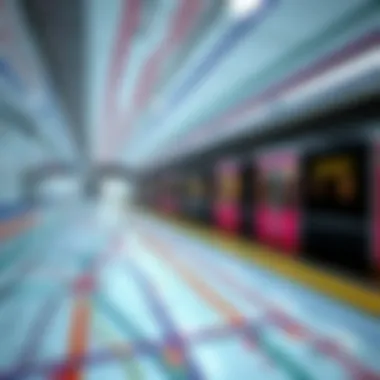
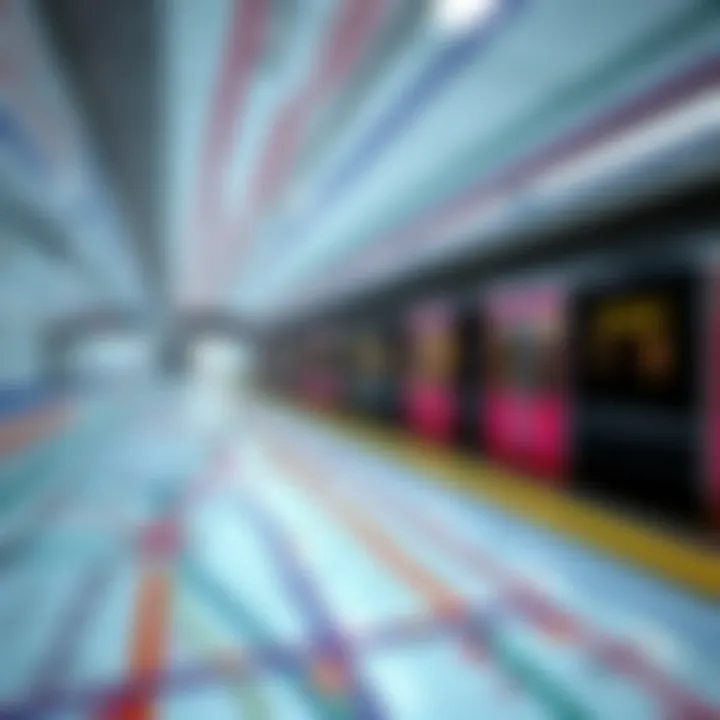
This holistic transport approach doesn't just save time; it significantly enhances user experience, making public transit a preferred option for more people.
Impact on Traffic Reduction
The benefits of a well-implemented metro system extend well beyond its immediate passengers. Ultimately, the Dubai Metro stands as a powerful tool in tackling the pressing issue of urban congestion, a common dilemma in many major cities.
By efficiently transporting thousands of passengers daily, the metro manages to alleviate pressure on roads, thus reducing the carbon footprint. Here are some notable impacts:
- Decrease in Dependence on Private Vehicles: As more residents embrace the metro, fewer cars crowd the roads, which can lead to a reduction in emissions and energy consumption.
- Enhanced Road Safety: With fewer vehicles on the road, there's a drop in traffic accidents, benefiting not only transit riders but also pedestrian safety.
- Facilitation of Urban Growth: Efficient public transport encourages higher population density in urban areas, resulting in optimized land use. This pattern supports the development of residential and commercial spaces around transit stations.
"Public transport systems like the Dubai Metro play a crucial role in transforming urban landscapes, encouraging sustainable living while combating congestion."
Public Sentiment on Metro Timings
Understanding public sentiment about the Dubai Metro's service hours plays a crucial role in shaping the overall perception of its effectiveness and efficiency. Insights from everyday commuters and visitors can provide a well-rounded perspective that reflects how these timings impact travel experiences within the bustling city. Both residents and tourists make use of this transportation system, and the feedback gathered sheds light not only on what users appreciate but also on areas that could benefit from enhancement.
Metro timings, being a core component of the commuting experience, significantly affect user satisfaction. Commuters' opinions encapsulate their feelings towards the availability of services, response times, and overall satisfaction with their travel on the metro. Regular evaluation of this sentiment is vital for continuous improvement and adaptation to the needs of a growing population.
Feedback from Regular Commuters
Regular commuters comprise a sizable portion of Dubai Metro's user base, and their feedback is invaluable. Many express satisfaction with the frequency and reliability of the service on weekdays, allowing them to efficiently plan their work commutes. Commuters appreciate the measures taken to maintain punctuality.
However, concerns often rise about the peak hours when the trains can be particularly crowded. Commuters have mentioned that during these rush hours, the experience can be rather uncomfortable. They sometimes suggest slight adjustments to the timetable to alleviate congestion; this could improve the commute by staggering arrivals or increasing the frequency of trains during peak times.
Some commuters have voiced their desire for more transparent communication regarding any service disruptions or changes in schedules. Many wish for real-time updates through notifications or apps, enabling them to make informed decisions and seek alternate routes when necessary.
“If we could get alerts about delays, it would be a game changer. No one likes being stuck in a crowded station with no idea why!” – A frequent commuter
Overall, feedback from regular commuters focuses on the blend of efficiency and user comfort, pointing out how important it is for the metro authorities to listen to the voices of those who rely on this service daily.
Visitor Experiences
For those unfamiliar with the underground lines, navigating the Dubai Metro presents a unique set of experiences ranging from delightful to perplexing. Most visitors express admiration for the streamlined design and cleanliness of the metro stations. They are often impressed by the ease of accessing various attractions within the city, thanks to the extensive connections the metro offers.
However, visitor experiences can be quite variable regarding timings, especially during weekends or holidays. Some tourists have remarked on how the limited hours on these days left them scrambling to find alternative modes of travel.
Feedback also reveals that while the map may seem straightforward, visitors sometimes struggle to comprehend the specifics of train schedules without local assistance or detailed guides. It becomes apparent that providing more accessible information about weekend service changes could significantly enhance their journey.
Additionally, cultural nuances play a role in how visitors perceive waiting times during peak hours. While some are familiar with busy public transport in their home countries, others may find the metropolitan pace daunting. The experience often hinges on both the clarity of information presented at metro stations and the willingness of irregular users to adapt.
In summary, visitor feedback underscores the necessity for improved communication concerning service hours along with user-friendly resources to navigate the Dubai Metro, ensuring travelers feel well-equipped to utilize this remarkable transit option.
Closure and Future Outlook
The significance of the conclusion and future outlook regarding the Dubai Metro is twofold. It not only summarizes the critical insights gathered throughout the article but also highlights the rapid advancements and strategic plans for enhancing the metro system in the future. Understanding what lies ahead provides invaluable context for investors, homeowners, expatriates, and transport enthusiasts alike, ensuring they are well-informed and prepared for shifts that may affect their daily commute or property investments.
Anticipated Changes in Service
As Dubai continues to evolve into a global metropolis, changes to the Dubai Metro’s service are expected. Factors such as increased commuter numbers and ongoing infrastructure projects play key roles in shaping these alterations. One notable development is the expansion of the metro network, with plans to potentially extend existing lines and introduce new ones. Such initiatives could change service frequencies during peak and off-peak hours, improving accessibility and convenience.
Furthermore, the integration of advanced technologies, such as contactless fare systems and real-time tracking apps, may soon take center stage. This would enhance customer experience significantly, allowing users to plan their journeys with greater precision and ease. Additionally, services like driverless trains could be introduced, aligning with ambitions for smarter urban transport solutions. The aim is to create a more responsive and user-friendly metro experience that caters to the growing demands of Dubai’s populace.
Long-term Impact on Urban Mobility
Examining the long-term ramifications of the Dubai Metro on urban mobility reveals how it could reshape the city’s transportation landscape. As the system expands, it has the potential to substantially reduce traffic congestion across major thoroughfares, as commuters swap personal vehicles for public transport. This shift can lead to healthier air quality and a more pleasant urban environment, aligning with the UAE's vision for sustainability.
Moreover, enhanced public transport options will likely contribute to increasing property values in areas adjacent to metro stations, making these regions more attractive to budding homeowners and investors. In the long run, the metro's role as a catalyst for suburban development cannot be understated, encouraging further economic activity and fostering social connections across the city.
To wrap up, the evolution of the Dubai Metro and its strategic enhancements not only address the needs of current passengers but also lay the groundwork for sustainable urban growth. Keeping a pulse on these developments can serve as a crucial advantage for anyone involved in the real estate market or daily commuting within this vibrant city.
“Investing in public transportation is investing in the future of a city.”
For further knowledge on Dubai's transport system and urban planning, you may refer to resources like Wikipedia, or engage with communities on platforms such as Reddit.








